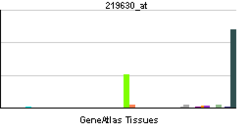- PDZK1IP1
-
PDZK1 interacting protein 1 Identifiers Symbols PDZK1IP1; DD96; MAP17; RP1-18D14.5; SPAP External IDs OMIM: 607178 MGI: 1914432 HomoloGene: 4213 GeneCards: PDZK1IP1 Gene Gene Ontology Cellular component • membrane
• integral to membraneSources: Amigo / QuickGO RNA expression pattern 
More reference expression data Orthologs Species Human Mouse Entrez 10158 67182 Ensembl ENSG00000162366 ENSMUSG00000028716 UniProt Q13113 Q9CQH0 RefSeq (mRNA) NM_005764 NM_026018 RefSeq (protein) NP_005755 NP_080294 Location (UCSC) Chr 1:
47.65 – 47.66 MbChr 4:
114.76 – 114.77 MbPubMed search [1] [2] PDZK1-interacting protein 1 is a protein that in humans is encoded by the PDZK1IP1 gene.[1][2][3][4][5]
Interactions
PDZK1IP1 has been shown to interact with PDZK1.[6][4][3]
References
- ^ Kocher O, Cheresh P, Brown LF, Lee SW (Feb 1999). "Identification of a novel gene, selectively up-regulated in human carcinomas, using the differential display technique". Clin Cancer Res 1 (10): 1209–15. PMID 9815914.
- ^ Kocher O, Cheresh P, Lee SW (Sep 1996). "Identification and partial characterization of a novel membrane-associated protein (MAP17) up-regulated in human carcinomas and modulating cell replication and tumor growth". Am J Pathol 149 (2): 493–500. PMC 1865305. PMID 8701988. http://www.pubmedcentral.nih.gov/articlerender.fcgi?tool=pmcentrez&artid=1865305.
- ^ a b Silver DL, Wang N, Vogel S (Jul 2003). "Identification of small PDZK1-associated protein, DD96/MAP17, as a regulator of PDZK1 and plasma high density lipoprotein levels". J Biol Chem 278 (31): 28528–32. doi:10.1074/jbc.M304109200. PMID 12754212.
- ^ a b Pribanic S, Gisler SM, Bacic D, Madjdpour C, Hernando N, Sorribas V, Gantenbein A, Biber J, Murer H (Sep 2003). "Interactions of MAP17 with the NaPi-IIa/PDZK1 protein complex in renal proximal tubular cells". Am J Physiol Renal Physiol 285 (4): F784–91. doi:10.1152/ajprenal.00109.2003. PMID 12837682.
- ^ "Entrez Gene: PDZK1IP1 PDZK1 interacting protein 1". http://www.ncbi.nlm.nih.gov/sites/entrez?Db=gene&Cmd=ShowDetailView&TermToSearch=10158.
- ^ Gisler, Serge M; Pribanic Sandra, Bacic Desa, Forrer Patrik, Gantenbein Andrea, Sabourin Luc A, Tsuji Akira, Zhao Zhuo-Shen, Manser Edward, Biber Jürg, Murer Heini (Nov. 2003). "PDZK1: I. a major scaffolder in brush borders of proximal tubular cells". Kidney Int. (United States) 64 (5): 1733–45. doi:10.1046/j.1523-1755.2003.00266.x. ISSN 0085-2538. PMID 14531806.
Further reading
- Kocher O, Comella N, Tognazzi K, Brown LF (1998). "Identification and partial characterization of PDZK1: a novel protein containing PDZ interaction domains.". Lab. Invest. 78 (1): 117–25. PMID 9461128.
- Göttgens B, Barton LM, Chapman MA, et al. (2002). "Transcriptional regulation of the stem cell leukemia gene (SCL)--comparative analysis of five vertebrate SCL loci.". Genome Res. 12 (5): 749–59. doi:10.1101/gr.45502. PMC 186570. PMID 11997341. http://www.pubmedcentral.nih.gov/articlerender.fcgi?tool=pmcentrez&artid=186570.
- Strausberg RL, Feingold EA, Grouse LH, et al. (2003). "Generation and initial analysis of more than 15,000 full-length human and mouse cDNA sequences.". Proc. Natl. Acad. Sci. U.S.A. 99 (26): 16899–903. doi:10.1073/pnas.242603899. PMC 139241. PMID 12477932. http://www.pubmedcentral.nih.gov/articlerender.fcgi?tool=pmcentrez&artid=139241.
- Gisler SM, Pribanic S, Bacic D, et al. (2004). "PDZK1: I. a major scaffolder in brush borders of proximal tubular cells.". Kidney Int. 64 (5): 1733–45. doi:10.1046/j.1523-1755.2003.00266.x. PMID 14531806.
- Gerhard DS, Wagner L, Feingold EA, et al. (2004). "The status, quality, and expansion of the NIH full-length cDNA project: the Mammalian Gene Collection (MGC).". Genome Res. 14 (10B): 2121–7. doi:10.1101/gr.2596504. PMC 528928. PMID 15489334. http://www.pubmedcentral.nih.gov/articlerender.fcgi?tool=pmcentrez&artid=528928.
- Gregory SG, Barlow KF, McLay KE, et al. (2006). "The DNA sequence and biological annotation of human chromosome 1.". Nature 441 (7091): 315–21. doi:10.1038/nature04727. PMID 16710414.
- Guijarro MV, Castro ME, Romero L, et al. (2007). "Large scale genetic screen identifies MAP17 as protein bypassing TNF-induced growth arrest.". J. Cell. Biochem. 101 (1): 112–21. doi:10.1002/jcb.21163. PMID 17230460.
- Guijarro MV, Leal JF, Fominaya J, et al. (2007). "MAP17 overexpression is a common characteristic of carcinomas.". Carcinogenesis 28 (8): 1646–52. doi:10.1093/carcin/bgm083. PMID 17426052.
- Guijarro MV, Leal JF, Blanco-Aparicio C, et al. (2007). "MAP17 enhances the malignant behavior of tumor cells through ROS increase.". Carcinogenesis 28 (10): 2096–104. doi:10.1093/carcin/bgm124. PMID 17548903.
Categories:- Human proteins
- Chromosome 1 gene stubs
Wikimedia Foundation. 2010.
